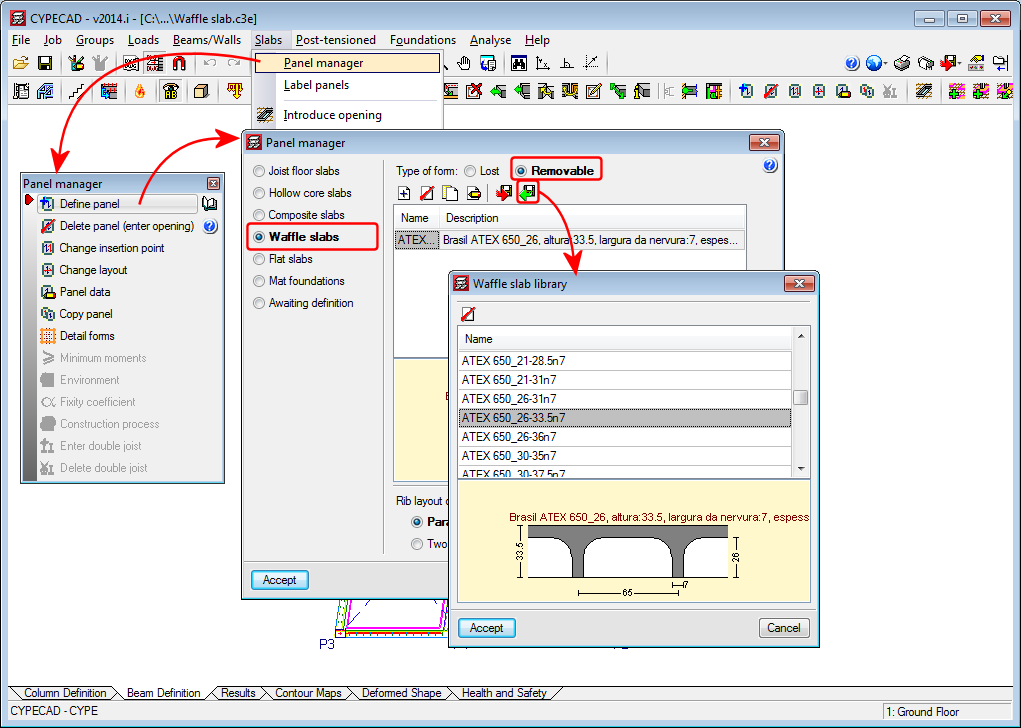New features of the 2014.i version
Improved code application. L and Z cold-formed sections for AISI/NASPEC-2007 (LRFD) (USA), AISI/NASPEC-2007 (LRFD) (Mexico) and CAN/CSA S136-07 (Canada)
- AISI/NASPEC-2007 (LRFD) (USA)
North American Specification for the Design of Cold-Formed Steel Structural Members. - AISI/NASPEC-2007 (LRFD) (México)
North American Specification for the Design of Cold-Formed Steel Structural Members. S136-07 Endorsed in Mexico by CANACERO. - CAN/CSA S136-07 (Canadá)
North American Specification for the Design of Cold-Formed Steel Structural Members. Approved in Canada by the Canadian Standards Association CSA.
These design standards were already implemented in CYPECAD and Metal 3D. As of the 2014.i version, the program implements the design of L and Z-shaped cold-formed sections.
Code implementation. NTDS. Norma Técnica para Diseño por Sismo (El Salvador)
Norma Técnica para Diseño por Sísmico (El Salvador)
Implemented in CYPECAD and Metal 3D.
The 2014.i version includes in CYPECAD:
- A static analysis method (equivalent lateral force)
The analysis method selection (dynamic or static) is carried out using the Analysis method option within the dialogue box where the seismic load is defined. - Correction due to base shear
This correction is applied to the seismic analysis using the dynamic analysis (spectral modal) method. To calculate the base shear with the ABNT NBR 15421:2006 code, CYPECAD offers two options for users to indicate the Fundamental period of the structure in two ways:
- Based on the code
- Specified by the user
More information on the correction due to base shear carried out by CYPECAD .
More information on how the fundamental period of the structure is determined .
Analyse the structure without obtaining the reinforcement
The 2014.i version includes a new analysis option: Analyse the structure without obtaining the reinforcement (Beam Definition tab > Analyse).
Using this option, users can obtain the forces and displacements of the structure without the need to design its elements. By not designing the elements, the time required to analyse the structure is reduced.
This can save users a substantial amount of time when structures requiring a long analysis period are being designed, since usually, the first analyses are used to check that the dimensions of the structural elements that have been introduced are adequate, so to avoid excessive displacements.
Implementation and update of ATEX (Brazil) removable form waffle slabs
New types of waffle slabs with removable forms, belonging to the Brazilian manufacturer ATEX, have been implemented. All floor slabs belonging to that manufacturer have also been updated. The 2014.i version has a total of 110 ATEX floor slabs available.
The previously mentioned implementation and update is available when one of the following Brazilian design codes has been selected:
- ABNT NBR 6118 Projeto Junho 2013
- ABNT NBR 6118:2007
- ABNT NBR 6118:2003
CYPECAD MEP for Spain
On the 12th September 2013, Order FOM/1635/2013, of the 10th September, was published in BOE Num. 219 (I. DISPOSICIONES GENERALES, MINISTERIO DE FOMENTO), updating the Documento Básico DB-HE “Ahorro de Energia”, of the Spanish Technical Building Code, approved by Royal Decree 314/2006, of the 17th March.
The 2014.i version of CYPECAD MEP incorporates, in its analyses and results, the modifications indicated in this Royal Decree regarding section HE 1 “Limitación de la demanda energética” and HE 4 “Contribución solar minima de agua caliente sanitaria”.
Furthermore, the new CYPETERM HE program can now be found in the main CYPE program menu, in the Building Services group.
Thermal analysis – HE 1
The analysis and code justification of the new CTE HE 1 for new building projects or extensions of existing buildings for private residential use have been implemented in the 2014.i version of CYPECAD MEP, within the Thermal study tab. Future versions will include buildings for other uses (which require the object building be analysed and compared to a reference building); and will be able to analyse buildings in accordance with the new “exigencia básica HE 0, de Limitación del consumo energético”.
The implementation of the analysis and justification of the new CTE DB HE 1 2013 in CYPE programs has brought about the creation of the program: CYPETERM HE, which is the real analysis motor to apply the HE 1 update.
The new analysis is present alongside the previous simplified option of the CTE DB HE 2006, as well as the option to export the building to LIDER so it may be analysed using the general option (both which will be revoked as of the 12th March 2014), and requires for it to be expressly activated in the “General data” menu, where it can be distinguished from the other options using the 2006 and 2013 suffixes.
More information on the implementation of the new DB HE 1 in CYPECAD MEP can be found in the new features of the 2014.i version on our Spanish webpage.
Solar thermal energy – HE 4
As of the 2014.i version, CYPECAD MEP incorporates, in its analysis and results, the modifications indicated in Royal Decree 314/2006 of the 17th March regarding section HE 4, “Contribución solar minima de agua caliente sanitaria”.
Users can opt to analyse in accordance with CTE DB-HE 4 of 2006 or with the modified document, CTE DB-HE 4 of 2013, by selecting the code to apply from the General data menu.
In addition to the adaptation to the changes in the CTE, the possibility to edit the monthly occupation percentage is also added in the General data menu.
More information on the implementation of the new DB-HE 4 in CYPECAD MEP can be found in the new features of the 2014.i version on our Spanish webpage .






